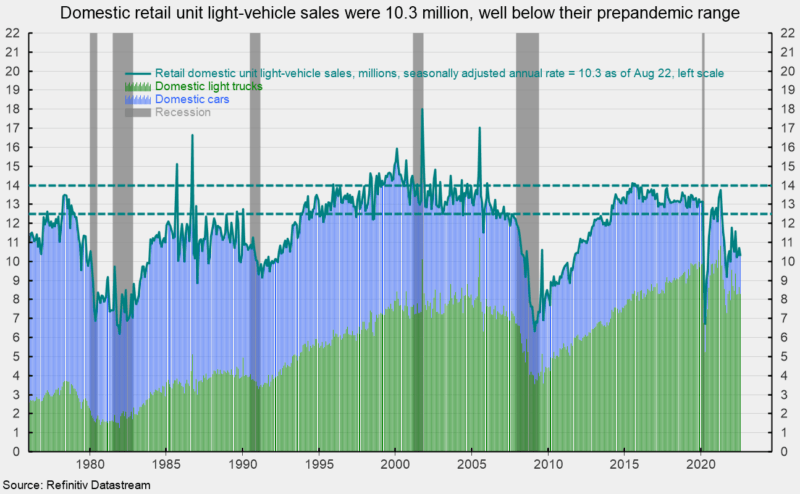Sales of light vehicles totaled 13.2 million at an annual rate in August, little changed from a 13.3 million pace in July. The August result was a 1.1 percent decrease from the prior month and the third decrease in the last six months. It was the fifteenth consecutive month below the 16 to 18 million range, averaging just 13.56 million over that period (see first chart). Weak auto sales are largely a result of component shortages that have limited production, resulting in plunging inventory and surging prices.
Breaking down sales by the origin of assembly, sales of domestic vehicles decreased to 10.3 million units versus 10.7 million in July, a drop of 3.9 percent, while imports jumped to a 2.88 million rate, a rise of 10.3 percent. Domestic sales had generally been in the 13 million to 14 million range in the period before the pandemic, averaging 13.3 million for the six years through December 2019. The domestic share came in at 78.1 percent in August versus 80.4 in July.
Within the domestic light-vehicles category, domestic car sales were 1.99 million in August versus 2.05 million in July, a drop of 2.6 percent. Domestic light truck sales were 8.31 million versus 8.67 million in the prior month, a drop of 4.2 percent. That puts the domestic light truck share of total domestic auto sales at 80.6 percent (see second chart).

Domestic assemblies jumped in July, coming in at 10.72 million at a seasonally adjusted annual rate. That is up 6.9 percent from 10.02 million in June and still slightly below the 10.8 million average pace for the three years through December 2019 (see third chart).
Component shortages, especially computer chips, continue to restrain production for most manufacturers, creating scarcity for many models and leading to lower inventory and higher prices. Ward’s estimate of unit auto inventory came in at 97,000 in July, up from 114,100 in June, and a new all-time low (see fourth chart). The Bureau of Economic Analysis estimates that the inventory-to-sales ratio fell to 0.505 in July, down from 0.558 in June but above the February low of 0.368 (see fourth chart).
The low inventory levels continue to push prices higher, with the average consumer expenditure for a car coming in at $34,962 in July, up 0.8 percent from June to a new record high (see fifth chart). The average consumer expenditure on a light truck rose to $50,320 from $50,143 in June, up 0.4 percent for the month and a new record high (see fifth chart).
As a share of disposable personal income per capita, average consumer expenditures on a car came in at 62.47 percent versus 62.09 in June and up sharply from 51.8 percent in December 2019. The average consumer expenditure on a light truck as a share of disposable personal income per capita was 89.91 percent versus 89.75 percent in June and 78.78 percent in December 2019 (see fifth chart).
* This article was originally published here
PUBLISH WITH US!
The Washington Gazette works at our discretion with businesses, non-profits, and other organizations. We do not work with socialists, crony capitalists, or disinformation groups. Click the green button below to view our services!
HELP STOP THE SPREAD OF FAKE NEWS!
SHARE our articles and like our Facebook page and follow us on Twitter!







0 Comments